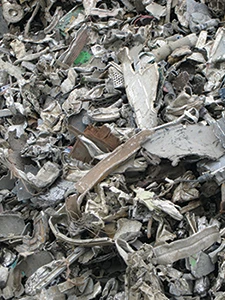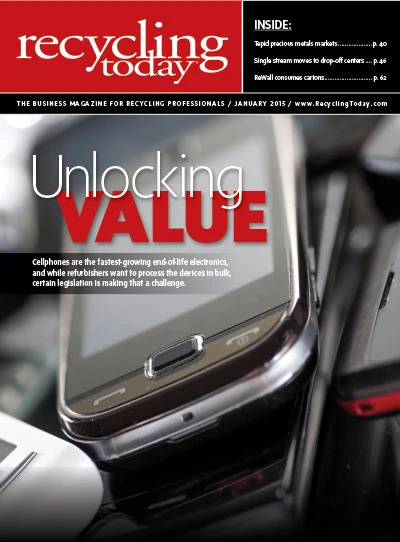
 Shippers of mixed nonferrous metals produced by shredding plants have enjoyed a robust market throughout the past 12 years, spurred in large part by strong demand from China.
Shippers of mixed nonferrous metals produced by shredding plants have enjoyed a robust market throughout the past 12 years, spurred in large part by strong demand from China.
Buyers of mixed grades, such as zorba (shredded nonferrous scrap that is predominantly aluminum) and zurik (sensor-sorted shredded nonferrous scrap that is predominantly stainless steel) have included nonferrous metals producers based in that nation as well as a network of downstream suppliers that take delivery of these mixed metals and sort them (often by hand) for the makers of secondary aluminum and red metals.
Domestic destinations for the mixed grades produced by shredders in the U.S. have not disappeared by any means, and interest in North America-based sorting of mixed metals was renewed by inconveniences stemming from China’s Operation Green Fence in 2013 and 2014.
Entering 2015, the attitude of China’s customs and inspection agencies toward mixed metals remains a concern among some recyclers and traders. Along with these concerns are hints by some in the mixed metals supply chain that the market may be ready for new methods of sorting, inspecting and raising the value of mixed grades that achieve higher purity standards.
By the book
Representatives of several Chinese government agencies, including China’s General Administration of Customs (GAC) and its Administration of Quality Supervision, Inspection and Quarantine (AQSIQ), were quick to refer to Operation Green Fence as a stepped-up enforcement policy toward regulations that had long been in place.
Inbound shipments of all materials were inspected more vigorously using methods that clogged up container ports and caused operational and financial headaches for importers and exporters of scrap materials.
The closest scrutiny has been reserved for plastic scrap, with this material having been singled out by many Chinese media outlets as an environmental hazard. Reports often refer to mixed loads of plastic scrap as “foreign garbage,” helping to deflect blame for China’s own environmental problems onto Western nations.
Producers of secondary nonferrous metals in China are well aware their metallic feedstocks are by no means “foreign garbage” and that purchasing the scrap materials is their single largest expense.
“The Green Fence is especially made for plastic scrap; it is not aimed at metal scrap,” says Simon Du, managing director of K&C International Consulting Co. Ltd. The Beijing-based company helps exporters apply for AQSIQ licensing.
The impact of Green Fence, Du says, was to “send out a signal that our Chinese government wants to carry out a much more strict policy on this, since plastic scrap pollutes more and, if we don’t handle it well, it harms our environment.”
Although plastic has been the target, that hasn’t stopped China’s regulators from scrutinizing inbound scrap metal shipments, with mixed shredded metals sometimes on the culprits list.
China’s National Standard GB 16487.7-2005, issued jointly in 2005 by AQSIQ and China’s Ministry of Environmental Protection (MEP), was designed to “prevent the import of solid wastes that cannot be used as raw materials, standardize the import examination and licensing of solid wastes as raw materials and control the environmental pollution caused by nonferrous metal scraps as raw materials,” according to the English-language version of the standard’s introduction.
The standard first addresses hazardous materials, including radiation, live ammunition and PCBs (polychlorinated biphenyls).
The document also sets a 2 percent limit on contaminants for inbound shipments: “In addition to the [hazardous] wastes listed above, other carried wastes (such as wood waste, waste paper, scrap plastic, scrap rubber, scrap glass, stripped rust, etc.) shall be restricted and their total weight shall not exceed 2 percent of the weight of the imported nonferrous metal scraps.”
Thus, during and subsequent to Operation Green Fence, the GB 16487.7-2005 standard provides inspectors with a reason to look for contaminants in metals shipments and sets a threshold to which buyers and sellers may ultimately have to comply.
Passing inspection
Shippers and receivers of scrap materials sent to China have had their business models squeezed by an inspection process that causes significant delays and involves additional labor to get a load from point A to point B.
The process includes preinspections at points of origin, photographic documentation and most often two more inspections at the Chinese entry port.
While the sheer amount of attention to inspections has multiplied, recyclers in North America and importers in China alike question the qualifications of some of the inspectors as well as the lack of scientific rigor of the inspection methodology.
Inspections are visual and are likely to single out bits of insulated copper wire (ICW)—especially if the plastic coating contrasts with the surrounding metals—and pieces of printed circuit boards mounted on green plastic.
Tim Shuttleworth, president and CEO of equipment provider Eriez, Erie, Pennsylvania, says, “The inspections are not particularly rigorous, I think in part due to poor inspection methods.”
Shuttleworth says he talks regularly to his customers who produce shredded mixed metals to find out where their sorting challenges lie. “The green boards are an easy catch by officials,” says Shuttleworth, who adds that this is more pertinent to zurik shipments as opposed to zorba.
Most recyclers who send zorba and zurik to China “know they are not in compliance” with the 2 percent threshold, continues Shuttleworth, because the buyers of the scrap ultimately assay their material and tell them the true residuals content.
The system as it currently stands, therefore, presents two potential problems, he says: Shippers and importers are worried that strict enforcement of the 2-percent-residuals limit could occur anytime and the ability of buyers to still get lower-value shipments through customs creates little incentive for shredder operators to upgrade the quality of their mixed metals products.
Chemistry class
The specifications for zorba and zurik as defined by ISRI (the Institute of Scrap Recycling Industries), Washington, include a phrase common to many grades in the organization’s circular: “subject to agreement between buyer and seller.”
Despite China’s National Standard GB 16487.7-2005 seemingly eroding some of the “wiggle room” found in that phrase, some recyclers and traders say neither the current inspection regimen nor current market forces reward recyclers who ship cleaner loads of zorba or zurik to China.
Shuttleworth says one of the shredder operators he communicated with admitted that he is better off achieving a metals recovery rate in his zorba that does not make him a market leader but rather in the “middle of the pack” in terms of quality, since there is no return on investment (ROI) from the market for higher quality material.
Whether any of the barriers to achieving that ROI will fall soon is a question of interest to shredder operators, zorba buyers and technology providers who could help change methodologies.
In the shredded ferrous scrap sector, bulk analysis is a cooperative approach that has been taken by some steelmakers and shredder operators. Gamma-Tech LLC, Dayton, Kentucky, says it has analyzed more than 10 million tons of shredded ferrous scrap since 2002 in an inline process that costs from $1.50 to $2 per ton.
According to Daniel Pflaum, president of Gamma-Tech, “We’re not sampling, we’re truly measuring the depth of the material on a composite basis, and the measurement is taken as real-time process control information.” Pflaum added in a 2011 interview with Recycling Today, “We’re installed on shredder systems producing from 80 to 400 tons per hour of material.”
In the case of ferrous scrap, shredded material analyzed in bulk and found to be below a certain copper-containing threshold can fetch a premium price or be sold to a wider variety of mill destinations.
Technology providers such as Shuttleworth are intrigued by the notion of bringing similar technology to bear in the analysis and marketability of mixed nonferrous metals. He says he thinks zorba and zurik buyers and sellers could accrue advantages.
“Frankly, the Chinese are correct to desire not to get 10 percent residuals along with every 90 percent of metal. We are dumping waste as a byproduct of metal sales,” he comments.
But, Shuttleworth quickly adds, “I feel sellers are really the ones in a disadvantaged position. They never get a premium when their zorba is cleaner than the specification—they only get hit when it is worse. And, when it is richer in red metals, they likewise never get a premium; but, if it is deficient, they get deductions. It is a fundamental conflict of interest that the buyers assay the consignments,” he says.
Shuttleworth borrows a phrase from former president Ronald Reagan, “trust but verify,” which the president applied to relations with the former Soviet Union. “But in this case the only verification [open to shippers of zorba] is the awkward process of sending a consignment to another buyer,” he says.
For as long as shredder operators have been producing mixed nonferrous grades, they have tolerated and looked for ways to benefit from the opaque aspects of these markets. Whether China’s National Standard GB 16487.7-2005 or fears of being on the losing side of too many negotiations can bring about greater transparency is an unanswered question.
The author is editor of Recycling Today and can be contacted at btaylor@gie.net.

Explore the January 2015 Issue
Check out more from this issue and find your next story to read.
Latest from Recycling Today
- BMW Group, Encory launch 'direct recycling’ of batteries
- Loom Carbon, RTI International partner to scale textile recycling technology
- Goodwill Industries of West Michigan, American Glass Mosaics partner to divert glass from landfill
- CARI forms federal advocacy partnership
- Monthly packaging papers shipments down in November
- STEEL Act aims to enhance trade enforcement to prevent dumping of steel in the US
- San Francisco schools introduce compostable lunch trays
- Aduro graduates from Shell GameChanger program





